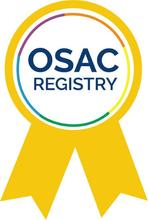August 2020
This Standards Bulletin from the Organization of Scientific Area Committees (OSAC) for Forensic Science provides an update on:
- Standards moving through the OSAC Registry approval process.
- Standards moving through the development process at standards developing organizations (SDOs).
New standards placed on the OSAC Registy: 0
OSAC Registry documents open for comment: 6
SDO documents open for comment: 7
In this issue
OSAC Registry Updates

The OSAC Registry serves as a repository of scientifically sound forensic science standards that address discipline-specific forensic science needs. OSAC elevates standards to the OSAC Registry as an endorsement of the document’s high quality and to encourage its use by relevant stakeholders in the forensic science community.
Intent to Add to the OSAC Registry - Items Open for Comment
The following SDO published standards are being considered for the OSAC Registry. Please submit your comments by 11:59 p.m. ET on September 4, 2020 on whether they should be included on the OSAC Registry:
-
ASTM E1388-17 Standard Practice for Static Headspace Sampling of Vapors from Fire Debris Samples. Submit your comments here.
-
ASTM E1412-19 Standard Practice for Separation of Ignitable Liquid Residues from Fire Debris Samples by Passive Headspace Concentration with Activated Charcoal. Submit your comments here.
-
ASTM E1413-19 Standard Practice for Separation of Ignitable Liquid Residues from Fire Debris Samples by Dynamic Headspace Concentration onto an Adsorbent Tube. Submit your comments here.
-
ASTM E3189-19 Standard Practice for Separation of Ignitable Liquid Residues from Fire Debris Samples by Static Headspace Concentration onto an Adsorbent Tube. Submit your comments here.
The following “OSAC Proposed Standards” are being considered for the OSAC Registry. Submit your comments/suggestions on the wording included in these draft standards and indicate whether they should be included on the OSAC Registry. To submit your feedback, complete the OSAC comment template and send it to forensics [at] nist.gov (forensics[at]nist[dot]gov) by 11:59 p.m. ET on September 4, 2020.
- Standard for Qualifications in the Practice of Forensic Anthropology.
- Best Practice Recommendations for the Management and Use of Quality Assurance DNA Elimination Databases in Forensic DNA Analysis.
In the Comment Adjudication Phase
- ANSI/ASB Standard 019, Wildlife Forensics General Standards, First Edition, 2019.
- ANSI/ASB Standard 029, Report Writing in Wildlife Forensics: Morphology and Genetics, First Edition, 2019.
- ANSI/ASB Standard 030, Standard for a Quality Assurance Program in Bloodstain Pattern Analysis, First Edition, 2019.
- ANSI/ASB Standard 045, Standard for Stature Estimation in Forensic Anthropology, First Edition, 2019.
- ANSI/ASB Standard 046, Wildlife Forensics Validation Standards – STR Analysis, First Edition, 2019.
- ANSI/ASB Standard 048, Wildlife Forensics DNA Standard Procedures, First Edition, 2019.
- ANSI/ASB Standard 072, Standard for the Validation of Procedures in Bloodstain Pattern Analysis, First Edition, 2019.
- ANSI/ASB Standard 090, Standard for Sex Estimation in Forensic Anthropology, First Edition, 2019.
- ANSI/ASB Standard 106, Wildlife Forensics – Protein Serology Methods for Taxonomic Identification, First Edition, 2020.
- ASTM E3233-20 Standard Practice for Forensic Tape Analysis Training Program.
- ASTM E3234-20 Standard Practice for Forensic Paint Analysis Training Program.
At FSSB for Vote
For a list of all standards currently under Registry consideration, please visit the OSAC website.
Has your organization already started implementing the OSAC Registry standards?
Complete OSAC's Laboratory Implementation Declaration Form and send it to mark.stolorow [at] nist.gov (mark[dot]stolorow[at]nist[dot]gov) to let us know. Share your implementation experience and be featured in a future OSAC news post.
SDO Updates
Published
The American Academy of Forensic Sciences Standards Board (ASB) has recently published two new documents:
- ANSI/ASB Standard 018, Standard for Validation of Probabilistic Genotyping Systems, First Edition, 2020. This standard, initially developed by OSAC’s Biological Data Interpretation & Reporting Subcommittee and finalized by ASB’s DNA Consensus Body, provides an essential framework for forensic laboratories validating a probabilistic genotyping system for the interpretation of autosomal STRs. Forensic laboratories that already use a probabilistic genotyping system can review their validation for compliance with this standard and supplement their previous validation where necessary.
- ANSI/ASB Best Practice Recommendation 089, Best Practice Recommendation for Facial Approximation in Forensic Anthropology, First Edition, 2020. This document, initially developed by OSAC’s Anthropology Subcommittee and finalized by the ASB Anthropology Consensus Body, provides guidance for facial approximation from skeletal remains. The production and assessment of facial approximations using skeletal remains represents a combination of varied methods of art and anatomical science that continue to evolve. Therefore, recommendations for specific techniques are not addressed. Facial imaging procedures such as composite drawings and postmortem imaging from photographs are not addressed.
Comment Period Open on Draft Documents
ASB:
- ASB Standard 014, Standard for Friction Ridge Examination Training Program. This document provides the requirements for a forensic service provider’s (FSP’s) training program for friction ridge examiners and includes recommended learning outcomes for the trainee. This document does not provide lesson plans, practical exercises, or performance measures for successful completion of each module. Individual sections only apply to trainees who perform those job functions. Comment deadline August 20, 2020.
- Recirculation* – ASB Standard 024, Canine Detection of Humans: Location Check Using Pre-Scented Canines. This document provides the requirements for pre-scented canine location check search using a canine team to search for and identify a specific person’s (target) scent at a given location. This standard promotes consistency across agencies, departments, and organizations utilizing pre-scented canines’ location check search and provide the judicial system optimized protocol. Comment deadline August 24, 2020.
- ASB Standard 096, Standard Method for the Examination and Documentation of Ammunition and Ammunition Components. This new standard provides procedures for the examination and documentation of ammunition and/or ammunition components by forensic firearm and toolmark examiners or technicians. Following these procedures, an examiner or technician will be able to document and report the examination of ammunition and/or ammunition components. This document does not cover the microscopic comparison of toolmarks on ammunition components. Comment deadline September 7, 2020.
- Recirculation* – ASB Standard 119, Standard for the Analytical Scope and Sensitivity of Forensic Toxicological Testing of Blood in Medicolegal Death Investigations. This document delineates the minimum requirements for target analytes and analytical sensitivity for the forensic toxicological testing of blood specimens collected in medicolegal death investigations. This document does not cover the analysis of urine, tissues, or other specimens that are commonly analyzed in medicolegal death investigations. Comment deadline September 7, 2020.
- Recirculation* – ASB Standard 120, Standard for the Analytical Scope and Sensitivity of Forensic Toxicological Testing of Blood in Impaired Driving Investigations. This document delineates the minimum requirements for target analytes and analytical sensitivity for the forensic toxicological testing of blood specimens collected from drivers suspected of being impaired. This document does not cover the analysis of breath, oral fluid, urine, or other potential specimen types collected in impaired driving investigations. Comment deadline September 7, 2020.
- Recirculation* – ASB Standard 121, Standard for the Analytical Scope and Sensitivity of Forensic Toxicological Testing of Urine in Drug-Facilitated Crime Investigations. This document delineates the minimum requirements for target analytes and analytical sensitivity for the forensic toxicological testing of urine specimens collected from alleged victims of drug-facilitated crimes (DFC). This document does not cover the analysis of blood and other evidence that may be collected in DFC cases. Comment deadline September 7, 2020.
- ASB Standard 135, Anthropology Scene Detection and Processing. This document provides requirements and best practices for forensic anthropology and forensic archaeology practitioners in proper scene detection, processing, handling of evidence, and maintenance of a chain of custody, commensurate with jurisdictional requirements. These requirements and best practices use archaeological techniques and principles as a foundation for scientifically appropriate detection, processing, documentation, and collection of human remains and associated evidence at a scene. Comment deadline September 7, 2020.
*Comments on a re-circulations will only be accepted on revised sections of a document. Comments made to text not revised from the original comment period will not be accepted.
For the ASB documents listed above, download the comment template and return it to asb [at] aafs.org (asb[at]aafs[dot]org) by the comment deadline.
Work Proposals for New or Revised Standards
The following documents are being initiated and are expected to result in a new or revised standard.
ASB:
- On July 31, 2020 a Project Initiation Notification System (PINS) was published on page 30 in the ANSI Standards Action. This will begin a 30-day period for public comment on the initiation of ASB’s work on the following documents:
- BSR/ASB BPR 143-202x, Best Practice Recommendations for Technical Review in Friction Ridge Examination. This document provides best practice recommendations for conducting technical reviews of friction-ridge impression examinations and general guidance on best practices for technical reviews, including a checklist and sample review forms. This document does not address administrative review or verification.
- BSR/ASB Std 145-202x, Standard for Consultation during Friction Ridge Examination. This standard sets documentation, quality, and consultant requirements for consultations during friction-ridge examinations. This document does not apply to conflict resolution.
Other News
Three-Part Webinar Series on Biology/DNA Standards and Best Practices

Join OSAC, ASB and Promega for a three-part webinar series that will provide information on new/emerging standards and best practice recommendations for forensic biology and DNA testing laboratories.
- Development and Publication of New Standards and Best Practices – The Process (Part 1) – available on-demand
- Mixture Interpretation Validation, and Protocol Development and Verification (Part 2) – Wednesday, August 5
- Training Standards Overview (Part 3) – Wednesday, September 9
Register for the series here.
Development of the Term "Exclusionary Difference" and a More Uniform Use of Spectral Comparison Language
Read more from Diana Wright, chair of OSAC’s Materials (Trace) Subcommittee, in the July 2020 issue of the American Society of Trace Evidence Examiners (ASTEE) Newsletter, page 11, regarding a brief history of the evolution of the terms used to describe the differences between items being compared from “significant” to “meaningful” to “exclusionary differences.”
Get Involved with OSAC
OSAC offers a variety of ways for members, affiliates and other experts in the forensic science community to participate in the standards advancement process. Click here to learn how you can help make an impact on the forensic science community through standards.

